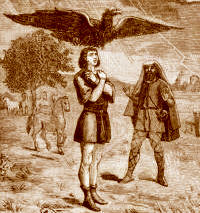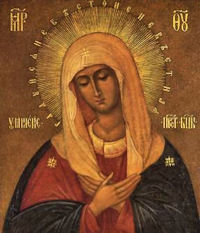Make your gift today!
Help keep Catholics around the world educated and informed.
Already donated? Log in to stop seeing these donation pop-ups.
Ordinary Time: June 8th
Wednesday of the Tenth Week in Ordinary Time
Other Commemorations: Mary, Mediatrix of All Graces (Hist); St. Medard, Bishop (RM)
» Enjoy our Liturgical Seasons series of e-books!
Gospel Verse, Ps 25:4b, 5a:
Teach me your paths, my God, and guide me in your truth.
Today the Roman Martyrology commemorates St. Médard, Bishop of Noyon, France. Legend says that once when he was a child a sudden shower fell, soaking everyone except St. Médard who remained perfectly dry, because an eagle had spread its wings over him. Ever since, Médard was known as "master of rain" or his patronage against bad weather and who to invoke for good weather. In religious art, an eagle shelters Médard from the rain.
The 1962 Missal commemorates Mary, Mediatrix of All Graces. Pope Leo XIII declared in his Encyclical Octobri Mense (On The Rosary) of September 22, 1891: "With equal truth may it be also affirmed that, by the will of God, Mary is the intermediary through whom is distributed unto us this immense treasure of mercies gathered by God, for mercy and truth were created by Jesus Christ."
Today is Ember Wednesday of the Summer or Pentecost Embertide.. These Ember Days fall during the week after Pentecost, near the summer solstice. The three principle focal points for the Ember Days of this period of the year are: 1) to ask God to bless especially the wheat harvest, 2) to thank God for the season of summer, and 3) to ask for special graces for those being ordained as priests during this season. Wednesday of Ember week is dedicated to Mary, it is a day of interior recollection. Friday is devoted to penance, while Saturday lays greatest stress on thanksgiving.
Because of the focus on wheat, the Ember Days of Summer have a Eucharistic focus, our “Bread of Life.” But also since the Ember Days are positioned during the traditional octave of Pentecost, there is also a Pentecostal flavor, to understand more deeply the riches and graces from the Holy Spirit especially as received at Pentecost. See Summer or Pentecost Ember Days and Contemporary Observation of Ember Days.
Mary, Mediatrix of All Graces
Traditionally today is the feast of Mary, Mediatrix of All Graces. All the graces which flow from the redemption of Jesus Christ are granted to the human family through the motherly intercession of Mary. Mary mediated Jesus Christ, the Author of all graces, to the world when she agreed to be the human mother of God made man (cf. Lk 1:38). And from the cross at Calvary (Jn 19:26) and as the final gift to humanity, Jesus gives Mary as a spiritual mother to us all: "Son, behold your mother" (cf. Jn 19:26). For this reason, Vatican II refers to Mary as a "mother to us in the order of grace " (Lumen Gentium, n. 62) and several twentieth century popes have officially taught the doctrine of Mary as Mediatrix of all graces, quoting the words of St Bernard: "It is the will of God that we obtain all favours through Mary." The Mediatrix performs this task in intimate union with the Holy Spirit, the Sanctifier, with whom she began the drama of our Lord's Redemption at the Annunciation (cf. Lk. 1:35).
Thirdly, Mary is our Advocate for people of God, in that she takes the petitions of her earthly children, especially in times of difficulties, and brings them through her maternal intercession before her Son and our Lord Jesus.
In the Old Testament, the Queen Mother brought the petitioned needs of the people of Israel to the throne of her son the king (cf. 1 Kings 2:19). Now Mary is the new Queen Mother and Advocate in the new Kingdom of her Son, who brings the petitioned needs of the people of God to the throne of her glorious Son, Christ the King, particularly in our present difficult times.
The universal mediation of the Mother of Jesus as Coredemptrix, Mediatrix of all graces, and Advocate for the people of God is already contained in the official and authoritative teachings of the Church's Magisterium. Now, at the summit of the Marian era, what remains is the final proclamation by the Church of this final Marian doctrine as Christian dogma revealed by God.
Highlights and Things to Do:
- Read these articles on Mediatrix of Graces by Fr. William G. Most (included in Catholic Culture's Father Most Collection):
- Pray the Litany of The Blessed Virgin Mary Mediatrix of All Grace
St. Médard of Noyon
Bishop of Noyon, born at Salency (Oise) about 456 and died in his episcopal city June 8, about 545. His father, Nectardus, was of Frankish origin, while his mother, named Protagia, was Gallo-Roman. It is believed that St. Gildardus, Bishop of Rouen, was his brother. His youth was entirely consecrated to the practise of Christian virtues and to the study of sacred and profane letters. He often accompanied his father on business to Vermand and to Tournai, and frequented the schools, carefully avoiding all worldly dissipation.
 His exemplary piety and his knowledge, considerable for that time, decided the Bishop of Vermand (d. 530) to confer on him Holy Orders, and caused him to be chosen as his successor. Forced, in spite of his objections, to accept this heavy charge, he devoted himself zealously to his new duties. In an effort to accomplish those duties in greater security, since Vermand and the northern part of France in general were then generally troubled by wars and exposed to the incursions of the barbarians, he removed his episcopal see in 531 from Vermand, a little city without defence, to Noyon, the strongest place in that region.
His exemplary piety and his knowledge, considerable for that time, decided the Bishop of Vermand (d. 530) to confer on him Holy Orders, and caused him to be chosen as his successor. Forced, in spite of his objections, to accept this heavy charge, he devoted himself zealously to his new duties. In an effort to accomplish those duties in greater security, since Vermand and the northern part of France in general were then generally troubled by wars and exposed to the incursions of the barbarians, he removed his episcopal see in 531 from Vermand, a little city without defence, to Noyon, the strongest place in that region.
The year following, St. Eleutherius, Bishop of Tournai, died and St. Médard was invited to assume the direction of that diocese also. He refused at first, but being urged by Clotaire himself he at last accepted. This union of the two dioceses lasted until 1146, when they were again separated.
Clotaire, who had paid him a last visit at Noyon, had his body transferred to the royal manor of Crouy at the gates of the city of Soissons. Over the tomb of St. Médard was erected the celebrated Benedictine abbey which bears his name.
St. Médard was one of the most honoured bishops of his time, his memory has always been popularly venerated in the north of France, and he soon became the hero of numerous legends. One of which says that if it rains on St. Médard's feast day it will be followed by forty days of rain; and forty days of sunshine will follow if it is clear.
—Excerpted from the Catholic Encyclopedia
Patronage: against bad weather; against imprisonment; against sterility; brewers; captives; harvests; for good weather; for rain; imprisoned people; mentally ill people; peasants; prisoners; toothache; vineyards.
Symbols and Representation: two white doves; three white doves; eagle; knife; ox; colt; torch; tooth;
Often Portrayed as: being sheltered from rain by an eagle or other large bird; holding a citadel; laughing aloud with his mouth wide open; leaving footprints in stone; with two horses at his feet
Highlights and Things to Do:
- Fourteen centuries ago as bishop of Tournai in Picardy, France, Médard founded the annual Rose Festival (Fetes des Roses). It is still held there on this day, and the region's most beautiful and virtuous maiden is crowned. According to CatholicSaints.info, "Rosiere is awarded to the young girl who has been judged the most virtuous and exemplary in the region of Salency, France; she is escorted by 12 boys and 12 girls to the church, where she is crowned with roses and given a gift of money. This is a continuation of a yearly stipend or “scholarship” he apparently instituted when bishop."
- Invoke St. Médard in cases against bad weather.
- Not only is St. Médard a patron of weather and meteorology, he is also a patron against toothaches, since he was depicted laughing with his mouth open.
- Read more about St. Médard:






